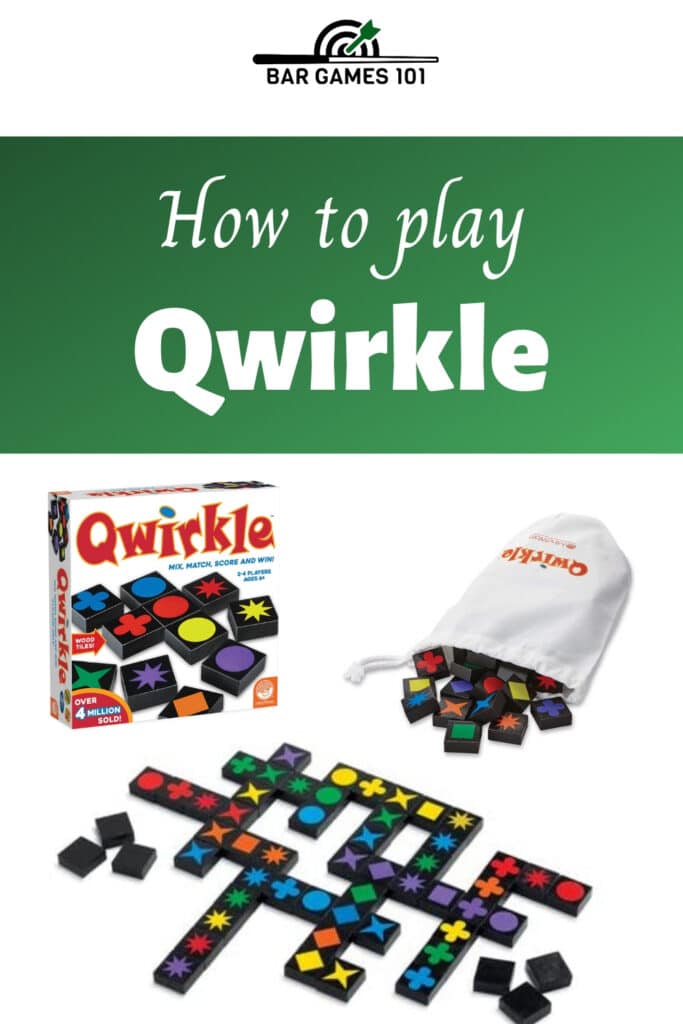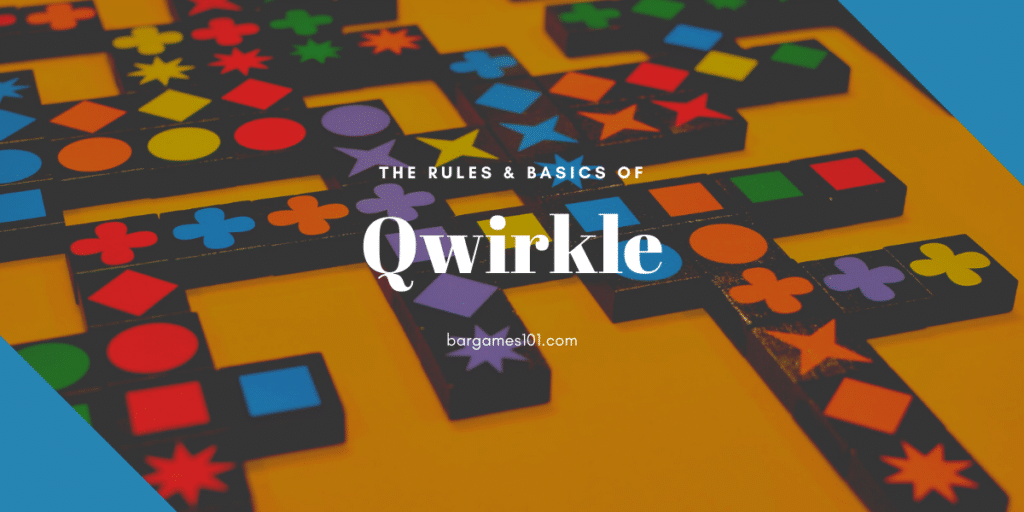How to Play Qwirkle: match colors and shapes, make lines, and score more points than your opponents.
On the surface that’s all there is to Qwirkle! The simple rules make this an ideal game for families, especially with younger children. It’s also very compact to store, taking up only the room of its tile bag if you ditch the box.
These features, combined with quick set-up and clean-up, make this a great option for a casual game night with friends as well.
Want to learn the rules of this tile matching game? Read on, and I’ll walk you through everything you need to know.
Qwirkle: The Essentials
- Players: 2-4
- Running Time: 30-60 min.
- Ages 6 and up
What’s In the Box?
- 108 Tiles: There are 6 different colors (red, orange, yellow, green, blue, and purple) and 6 different shapes (circle, cross, diamond, square, star, and x). These are the only components used in the game.
- 1 Bag: A drawstring bag to store your tiles in. This is all you’ll need to store the game!
- 1 Rule Book
Idea of the Game

I mentioned that the rules of Qwirkle are simple, right?
The object of the game is to score more points than your opponents before the game ends. To score these points, you must match and place tiles from your hand on the board in lines with other tiles of the same shape or color.
If that sounds simple, it’s because the concept is simple. There is a good depth of strategy the more you dive into the game, though, making it great to play over and over with the same group.
Love strategy games? Check out these posts:
- Dixit: A Simple Story Telling Game With Surprising Depth
- Risk Strategy: 9 Tips to Step Up Your Game
- How to Play Blokus
- 10 Best Strategy Board Games
Setting Up and Getting Started
First thing you’ll need to figure out is how you’ll be keeping score for this game of Qwirkle.
There aren’t any materials provided with the game set for this.
A pencil and paper is recommended, though you could also use a smartphone notepad app or something similar if that works better for you.
- Put all the tiles in the bag if they aren’t already in there.
- Shake the bag nice and vigorously to mix the tiles up.
- Allow each player to draw 6 tiles from the bag, keeping them hidden from the other players.
These will be your hand of available tiles, which you can play from on your turn.
Once hands are dealt, have everybody count up how many of their tiles share either a shape or a color.
Disregard duplicates for this count (for instance, if you have 2 blue square tiles you should only count 1 of them). Whoever has the most tiles of a kind goes first. In case of a tie, the eldest player takes the priority. The first player must play those tiles to start the board as their first turn.
Taking a Turn
Once the game kicks in, play will proceed in a clock-wise direction around the table.
Each player has a chance to do 1 of 3 possible actions.
- Place a tile on the table, next to a matching tile.
- Place a line of tiles on the table. They must also be attached to a matching tile already on the board, and must all be matching themselves.
- Trade away unwanted tiles for new ones from the bag. This passes your turn.
This makes for a quick pace to the game, with typically short turns.
Matching Tiles and Scoring Lines
This is most of what you’ll be doing in a game of Qwirkle. Each turn builds off the first line put down by the first player, eventually turning the gaming surface into a sprawling network of colors and shapes.
Every player, on their turn, is able to place 1 or more tiles on the table. To do so, the tile(s) they place must match either the color of the shape of the tile they’re being placed next to.
When two or more tiles on the table are touching, that is considered a line.
Lines are always either all one shape or all one color.
In order to add to existing lines on the table, you have to be able to match either the color or the shape of the other tiles in that line without duplicating one of the tiles. Making lines is how you score points!
Whenever you play down 1 or more tiles, count up how many tiles there are in lines they are in.
A tile can, and often will, be in multiple lines for a single play. This is the best way to maximize your points, since those lines add up for your point total that turn!
When a tile is in two lines, you score it for both lines when counting up your points that turn.
Keep in mind that you can’t force tiles into the grid where they don’t match.
Even when building off a different line on the grid, if any tiles in your attempted play would be touching a non-matching tile you can’t make that play.
There will be areas in the grid that get closed off to legal plays during the game!
Scoring a Qwirkle
The most tiles any line can have are 6 (since there are only 6 of each color and 6 of each shape in the game).
Managing to match a full line of 6 on your turn is a Qwirkle!
When you score a Qwirkle, score the lines you played that turn as usual. On top of that total, matching the full 6 tiles scores you 6 bonus points.
This gives a player a big point boost, so be careful about possibly setting your opponents up to get a Qwirkle when making your play!
Making a line of 5 tiles might be nice in the short term, but you’ll regret it if anybody at the table has the missing 6th tile to finish the line.
Trading Away Tiles
Sometimes in a game of Qwirkle, you find yourself stuck with a hand of tiles that just won’t play. It’s not hopeless. There’s a rule for that!
When you either don’t have a legal play in your hand, or if you just want to clean house a little, you can choose to trade any number of tiles in your hand for new ones from the bag.
Remember: Trading tiles is your action for that turn, so you can’t do any tile placing and scoring that turn.
To trade, put the tiles you want to get rid of face-down on the table. Draw an equal number of tiles from the bag and add them to your hand.
This isn’t a rule, but letting your opponents see what you are discarding is more information than you should want to offer up.
Then, put the tiles you are getting rid of back in the bag.
Doing the trade this way guarantees you won’t just pick up the exact tile you put in the bag. I’m sure that’s a relief.
Declaring the Winner
When the tile bag runs out of possible draws, continue playing around the table until somebody runs out of tiles.
The player that got rid of their hand of tiles first gets 6 bonus points for their efforts, and the game ends.
At this point, the player with the highest score is the winner!
A Fun Any Time Game
Qwirkle is the kind of game that doesn’t feel intimating to just decide to play on any given night. The easy set-up and clean-up make it ideal for those nights you are suddenly struck by a gaming mood but don’t have much time or energy.
The simple-to-learn rules of the game also make the perfect pick-up for a family game night.
The vibrant colors and shapes make interesting patterns as the game progresses, and as a bonus the game is a good exercise for a developing mind.
Despite the simplicity of the rules, Qwirkle features good strategic depth and can entertain countless replays over the years you own it!
What more could you want?
Top Image Credit: via yoppy @Flickr (modified)




